Higher Radiation Use Efficiency Produces Greater Biomass Before Heading and Grain Yield in Super Hybrid Rice
Abstract
:1. Introduction
2. Materials and Methods
2.1. Experimental Setup and Design
2.2. Meteorological Conditions
2.3. Plant Sampling and Measurements
2.3.1. Green Leaf Area Index and Above-Ground Biomass
2.3.2. Estimation of the Growth Pattern of Green Leaf Area
2.3.3. Fractional PAR Interception (f) and Light Extinction Coefficient (k)
2.3.4. Light Interception and Radiation Use Efficiency (RUE)
2.3.5. Leaf Net Photosynthesis Rate (A)
2.3.6. Yield and Yield Components
2.4. Statistical Analysis
3. Results
3.1. Climatic Conditions
3.2. Yield and Yield components
3.3. Above-Ground Biomass (AM)
3.4. Green Leaf Area Index (GLAI) and Fractional PAR Interception (f)
3.5. Radiation Interception and Radiation-Use Efficiency (RUE)
3.6. Leaf Net Photosynthesis Rate (A)
4. Discussion
5. Conclusions
Supplementary Materials
Author Contributions
Funding
Acknowledgments
Conflicts of Interest
References
- Khush, G. Green revolution: The way forward. Nat. Rev. Genet. 2001, 2, 815–822. [Google Scholar] [CrossRef] [PubMed]
- Peng, S.; Buresh, R.J.; Huang, J.; Zhong, X.; Zou, Y.; Yang, J.; Wang, G.; Liu, Y.; Hu, R.; Tang, Q.; et al. Improving nitrogen fertilization in rice by site-specific N management. A review. Agron. Sustain. Dev. 2010, 30, 649–656. [Google Scholar] [CrossRef]
- Yang, J.; Zhang, J.; Liu, L.; Wang, Z.; Zhu, Q. Carbon remobilization and grain filling in japonica/indica hybrid rice subjected to post-anthesis water deficits. Agron. J. 2002, 94, 102–109. [Google Scholar] [CrossRef]
- Katsura, K.; Maeda, S.; Horie, T.; Shiraiwa, T. Analysis of yield attributes and crop physiological traits of Liangyoupeijiu, a hybrid rice recently bred in China. Field Crops Res. 2007, 103, 170–177. [Google Scholar] [CrossRef]
- Cheng, S.; Zhuang, J.; Fan, Y.; Du, J.; Cao, L. Progress in research and development on hybrid rice: A super-domesticate in China. Ann. Bot. 2007, 100, 959–966. [Google Scholar] [CrossRef]
- Peng, S.; Khush, G.S.; Virk, P.; Tang, Q.; Zou, Y. Progress in ideotype breeding to increase rice yield potential. Field Crops Res. 2008, 108, 32–38. [Google Scholar] [CrossRef]
- Zhang, H.; Xue, Y.; Wang, Z.; Yang, J.; Zhang, J. Morphological and physiological traits of roots and their relationships with shoot growth in “super” rice. Field Crops Res. 2009, 113, 10–40. [Google Scholar] [CrossRef]
- Zhang, Y.; Tang, Q.; Zou, Y.; Li, D.; Qin, J.; Yang, S.; Chen, L.; Xia, B.; Peng, S. Yield potential and radiation use efficiency of super hybrid rice grown under subtropical conditions. Field Crops Res. 2009, 114, 91–98. [Google Scholar] [CrossRef]
- Xiong, J.; Ding, C.Q.; Wei, G.B.; Ding, Y.F.; Wang, S.H. Characteristic of dry-matter accumulation and nitrogen-uptake of super-high-yielding early rice in China. Agron. J. 2013, 105, 1142–1150. [Google Scholar] [CrossRef]
- Xu, Z.J.; Chen, W.F.; Huang, R.D.; Zhang, W.Z.; Ma, D.R.; Wang, J.Y.; Xu, H.; Zhao, M.H. Genetical and physiological basis of plant type model of erect and large panicle Japonica super rice in Northern China. Agric. Sci. China 2010, 9, 457–462. [Google Scholar] [CrossRef]
- Huang, M.; Zou, Y.B.; Jiang, P.; Xia, B.; Ibrahim, M.; Ao, H.J. Relationship between grain yield and yield components in super hybrid rice. Agric. Sci. China 2011, 10, 1537–1544. [Google Scholar] [CrossRef]
- Lv, C.G.; Li, X.; Chen, G.X. Photosynthetic characteristics and its physiological basis of super high-yielding hybrid rice Liangyoupeijiu. Sci. Agric. Sin. 2017, 50, 4055–4070. (In Chinese) [Google Scholar]
- Alex, W.; Al, D.; Farquhar, G.D.; Hammer, G.L. Simulating daily field crop canopy photosynthesis: An integrated software package. Funct. Plant Biol. 2018, 45, 362–377. [Google Scholar]
- Monteith, J.L. Climate and the efficiency of crop production in Britain. Philos. T. Roy. Soc. London, Ser.B. 1977, 281, 277–294. [Google Scholar]
- Sandaña, P.; Ramírez, M.; Pinochet, D. Radiation interception and radiation use efficiency of wheat and pea under different P availabilities. Field Crops Res. 2012, 127, 44–50. [Google Scholar] [CrossRef]
- Mitchell, P.L.; Sheehy, J.E. Supercharging rice photosynthesis to increase yield. New Phytol. 2006, 171, 688–693. [Google Scholar] [CrossRef]
- Massignam, A.; Chapman, S.; Hammer, G.; Fukai, S. Physiological determinants of maize and sunflower grain yield as affected by nitrogen supply. Field Crops Res. 2009, 113, 256–267. [Google Scholar] [CrossRef]
- Katsura, K.; Maeda, S.; Lubis, I.; Horie, T.; Cao, W.; Shiraiwa, T. The high yield of irrigated rice in Yunnan, China: ‘a cross-location analysis’. NJAS-Wagen. J. Life Sc. 2008, 107, 1–11. [Google Scholar]
- Huang, L.; Yang, D.; Li, X.; Peng, S.; Wang, F. Coordination of high grain yield and high nitrogen use efficiency through large sink size and high post-heading source capacity in rice. Field Crops Res. 2019, 233, 49–58. [Google Scholar] [CrossRef]
- Clerget, B.; Bueno, C.; Quilty, J.R.; Correa, T.Q.; Sandro, J. Modifications in development and growth of a dual-adapted tropical rice variety grown as either a flooded or an aerobic crop. Field Crops Res. 2014, 155, 134–143. [Google Scholar] [CrossRef]
- Murchie, E.H.; Yang, J.; Hubbart, S.; Horton, P.; Peng, S. Are there associations between grain-filling rate and photosynthesis in the flag leaves of field-grown rice? J. Exp. Bot. 2002, 53, 2217–2224. [Google Scholar] [CrossRef] [PubMed]
- Ahmad, S.; Ghulam, A.; Mukhtar, A.; Zartash, F.; Muhammad, A.A.; Ghulam, R.; Muhammad, A.K.; Gerrit, H. Climate warming and management impact on the change of phenology of the rice-wheat cropping system in Punjab, Pakistan. Field Crops Res. 2019, 230, 46–61. [Google Scholar] [CrossRef]
- Islam, M.R.; Sikder, S. Phenology and degree days of rice cultivars under organic culture. Bangladesh J. Bot. 2011, 40, 149–153. [Google Scholar] [CrossRef] [Green Version]
- Yin, X.; Goudriaan, J.; Lantinga, E.A.; Vos, J.; Spiertz, H.J. A flexible sigmoid function of determinate growth. Ann. Bot. 2003, 91, 361–371. [Google Scholar] [CrossRef]
- Cosentino, S.L.; Patanè, C.; Sanzone, E.; Testa, G.; Scordia, D. Leaf gas exchange, water status and radiation use efficiency of giant reed (Arundo donax L.) in a changing soil nitrogen fertilization and soil water availability in a semi-arid Mediterranean area. Eur. J. Agron. 2016, 72, 56–69. [Google Scholar] [CrossRef]
- Wei, H.H.; Meng, T.Y.; Li, C.; Xu, K.; Huo, Z.Y.; Wei, H.Y.; Guo, B.W.; Zhang, H.C.; Dai, Q.G. Comparisons of grain yield and nutrient accumulation and translocation in high-yielding japonica/indica hybrids, indica hybrids, and japonica conventional varieties. Field Crops Res. 2017, 204, 101–109. [Google Scholar] [CrossRef]
- Wei, H.Y.; Hu, L.; Zhu, Y.; Xu, D.; Zheng, L.M.; Chen, Z.F.; Hu, Y.J.; Cui, P.Y.; Guo, B.W.; Dai, Q.G.; et al. Different characteristics of nutrient absorption and utilization between inbred japonica super rice and inter-sub-specific hybrid super rice. Field Crops Res. 2018, 218, 88–96. [Google Scholar] [CrossRef]
- Jiang, G.; Guo, J.; Meng, Q.; Chen, Y.; Wang, H.; Hu, Z.; Kuang, T. Genes differentially expressed under photoinhibition stress in flag leaves of superhybrid rice Liangyoupeijiu (Oryza sativa) and their genetic origins. Photosynthetica 2005, 43, 231–236. [Google Scholar] [CrossRef]
- Wei, H.; Zhang, H.; Blumwald, E.; Li, H.; Cheng, J.; Dai, Q.; Huo, Z.; Xu, K.; Guo, B. Different characteristics of high yield formation between inbred japonica super rice and inter-sub-specific hybrid super rice. Field Crops Res. 2016, 198, 179–187. [Google Scholar] [CrossRef]
- Mae, T.; Inaba, A.; Kaneta, Y.; Masaki, S.; Sasaki, M.; Aizawa, M.; Okawa, S.; Hasegawa, S.; Makino, A. A large-grain rice cultivar, akita 63, exhibits high yields with high physiological n-use efficiency. Field Crops Res. 2006, 97, 227–237. [Google Scholar] [CrossRef]
- Xue, W.; Lindner, S.; Dubbert, M.; Otieno, D.; Ko, J.; Muraoka, H.; Werner, C.; Tenhunen, J. Supplement understanding of the relative importance of biophysical factors in determination of photosynthetic capacity and photosynthetic productivity in rice ecosystems. Agr. Forest Meteorol. 2017, 232, 550–565. [Google Scholar] [CrossRef]
- Takai, T.; Matsuura, S.; Nishio, T.; Ohsumi, A.; Shiraiwa, T.; Horie, T. Rice yield potential is closely related to crop growth rate during late reproductive period. Field Crops Res. 2006, 96, 328–335. [Google Scholar] [CrossRef]
- Huang, L.Y.; Sun, F.; Yuan, S.; Peng, S.B.; Wang, F. Different mechanisms underlying the yield advantage of ordinary hybrid and super hybrid rice over inbred rice under low and moderate N input conditions. Field Crops Res. 2018, 216, 150–157. [Google Scholar] [CrossRef]
- Qin, J.; Impa, S.M.; Tang, Q.; Yang, S.; Yang, J.; Tao, Y.; Jagadish, K.S.V. Integrated nutrient water and other agronomic options to enhance rice grain yield and N use efficiency in double-season rice crop. Field Crops Res. 2013, 148, 15–23. [Google Scholar] [CrossRef]
- Salvagiotti, F.; Miralles, D.J. Radiation interception, biomass production and grain yield as affected by the interaction of nitrogen and sulfur fertilization in wheat. Eur. J. Agron. 2008, 28, 282–290. [Google Scholar] [CrossRef]
- Yoshida, S. Fundamentals of Rice Crop Science, 1st ed.; IRRI: Los IRRI, Los Banos, Philippines, 1981; pp. 69–81. [Google Scholar]
- Huang, M.; Shan, S.; Cao, F.; Zou, Y. The solar radiation-related determinants of rice yield variation across a wide range of regions. NJAS-Wagen. J. Life Sc. 2016, 78, 123–128. [Google Scholar] [CrossRef]
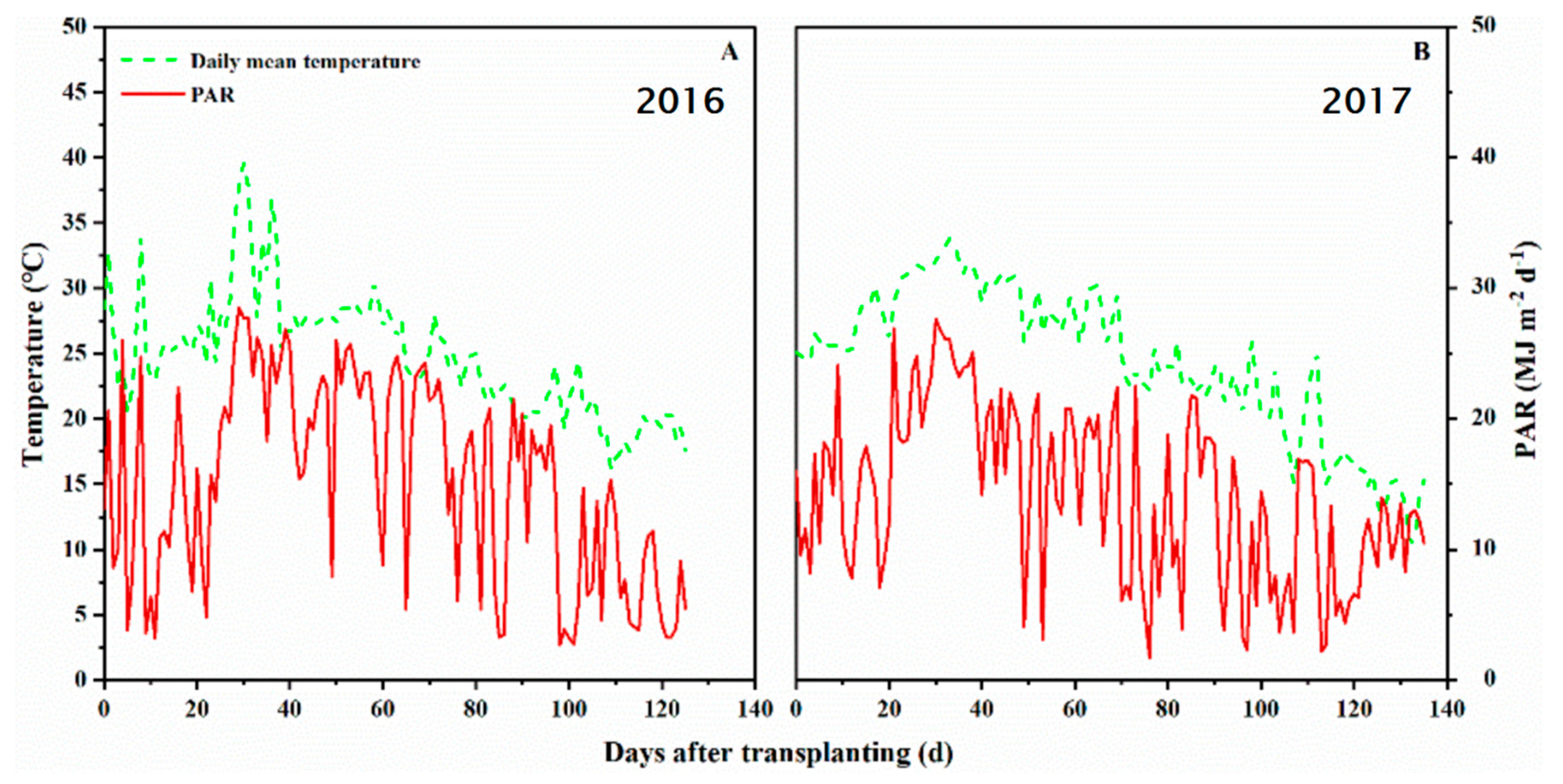
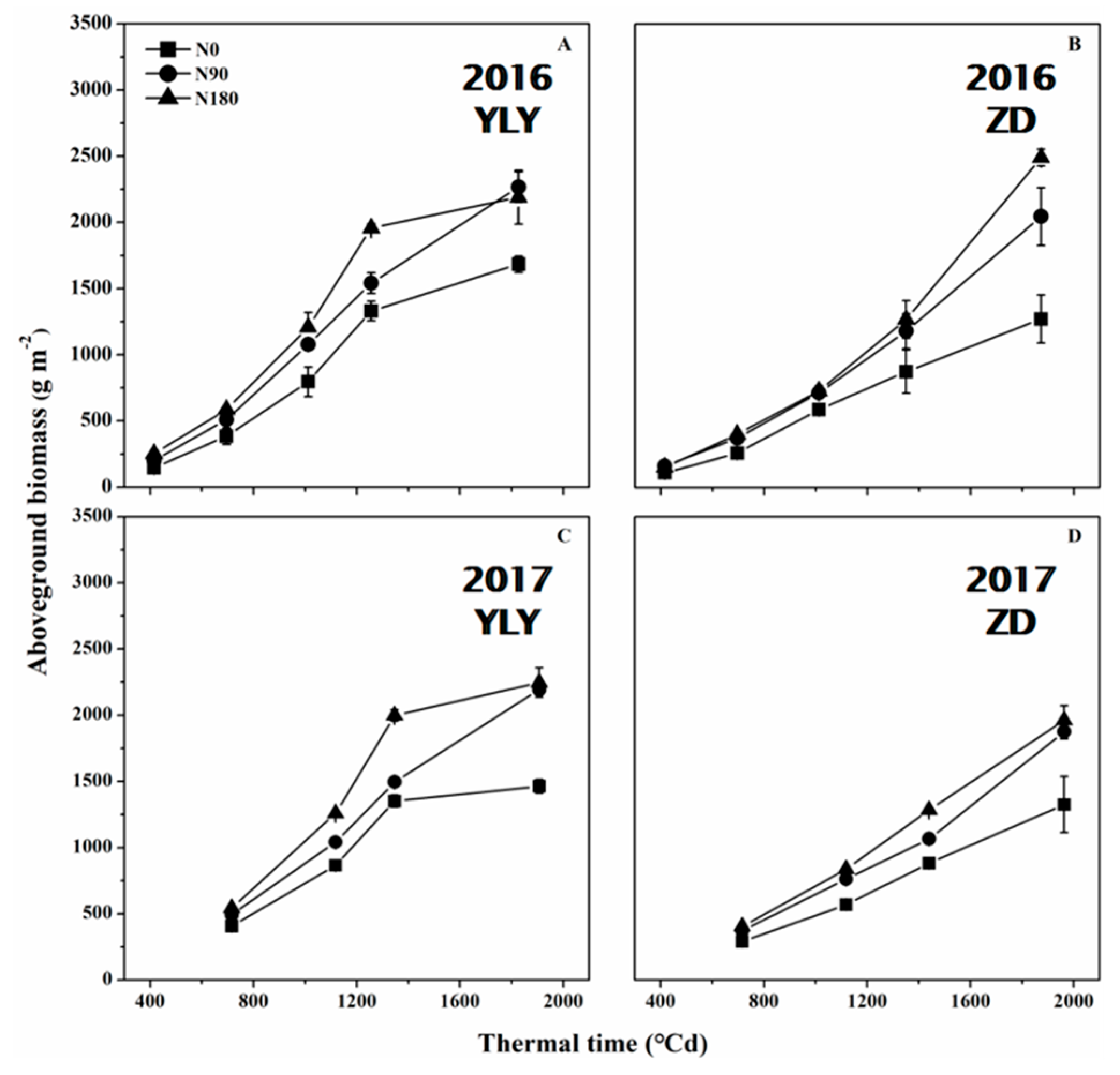
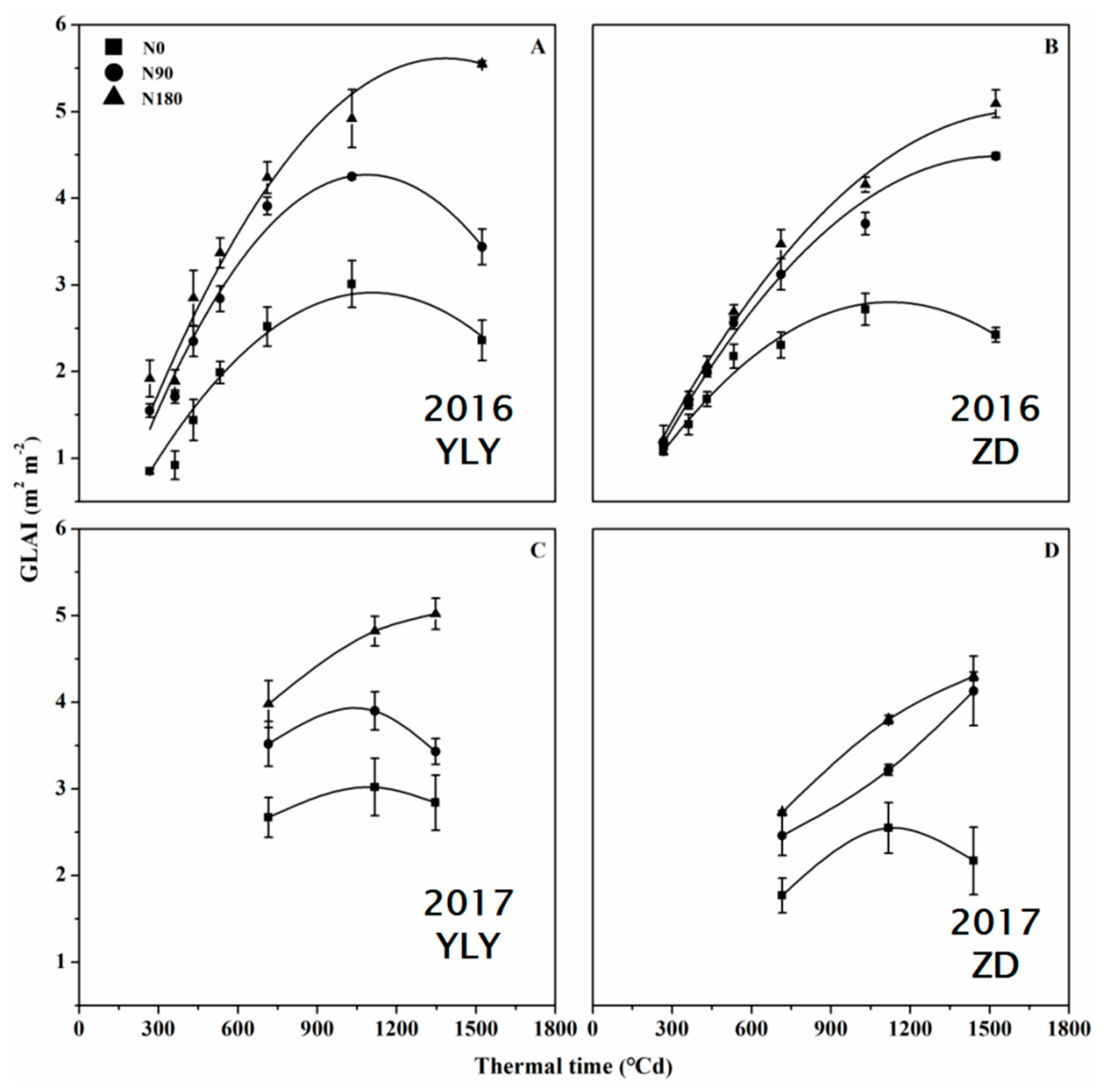


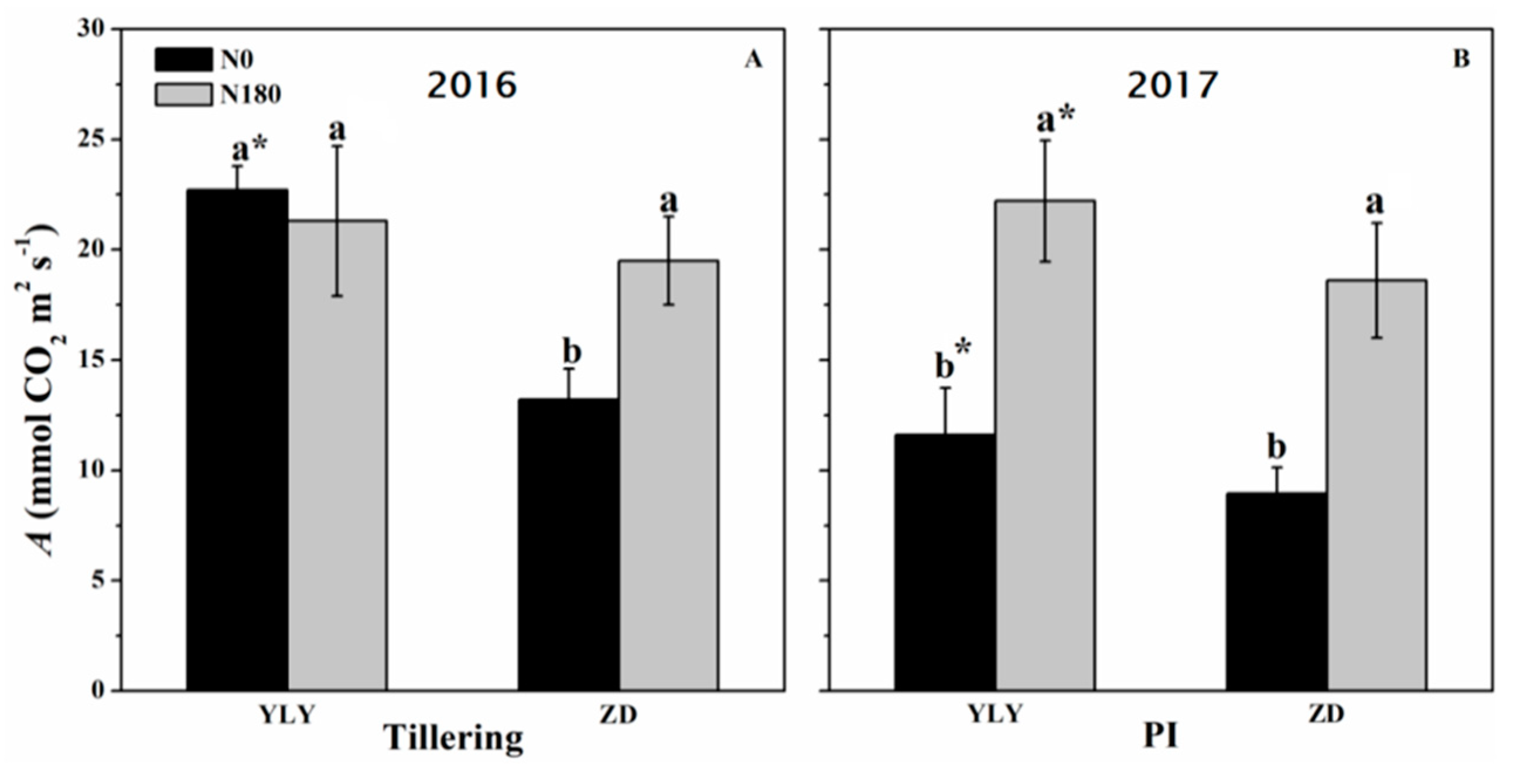
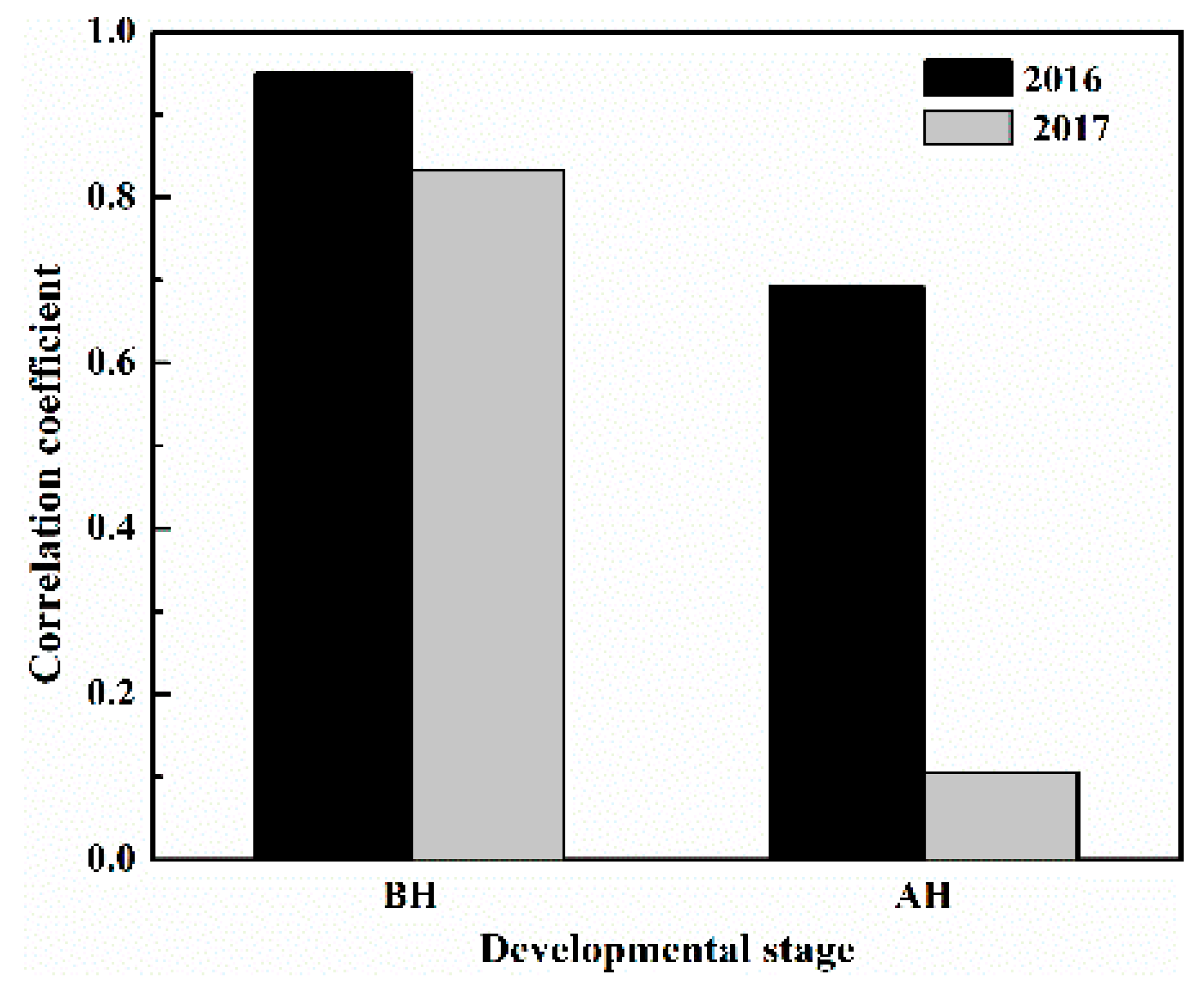
| Year | Cultivar | Nitrogen | Panicles m−2 | Spikelets Panicle-1 | Grain Filling Percentage (%) | 1000-Grain Weight (g) | Yield (t hm−2) |
|---|---|---|---|---|---|---|---|
| 2016 | YLY | N0 | 190.5 b | 204.3 b * | 94.6 a * | 23.8 a * | 8.8 b * |
| N90 | 261.9 a | 201.3 b * | 91.0 b * | 24.4 a * | 10.9 a * | ||
| N180 | 267.9 a* | 222.7 a * | 90.1 b * | 24.3 a * | 11.0 a * | ||
| N270 | 232.2 a* | 229.0 a * | 89.7 b * | 23.7 a | 10.2 ab * | ||
| N360 | 261.9 a* | 210.3 ab * | 84.8 c * | 23.7 a | 9.4 b * | ||
| ZD | N0 | 178.6 c | 125.2 b | 97.1 a | 28.1 a | 6.0 d | |
| N90 | 259.5 b | 133.8 ab | 97.5 a | 27.7 a | 7.2 c | ||
| N180 | 363.1 a | 132.4 ab | 95.5 ab | 26.7 a | 8.4 ab | ||
| N270 | 363.1 a | 141.5 a | 96.3 ab | 24.6 b | 9.1 a | ||
| N360 | 363.1 a | 136.5 ab | 94.9 b | 24.1 b | 8.1 b | ||
| 2017 | YLY | N0 | 156.3 d * | 192.2 a * | 94.3 a | 24.7 a | 7.9 c * |
| N90 | 183.5 c * | 204.0 a * | 94.1 ab | 24.6 a | 10.3 a * | ||
| N180 | 194.3 bc * | 185.9 a * | 93.6 ab | 24.8 a | 10.2 ab * | ||
| N270 | 201.0 b * | 197.4 a * | 93.0 ab | 24.2 a | 10.4 a * | ||
| N360 | 232.0 a * | 205.1 a * | 91.3 b | 24.5 a | 9.7 b * | ||
| ZD | N0 | 189.5 c | 126.9 b | 94.0 a | 27.0 a | 5.6 d | |
| N90 | 262.5 b | 142.6 ab | 95.7 a | 25.6 a | 7.6 c | ||
| N180 | 311.7 a | 145.4 ab | 95.4 a | 23.4 b | 8.2 b | ||
| N270 | 298.7 a | 158.2 a | 94.3 a | 23.0 b | 9.3 a | ||
| N360 | 302.3 a | 155.4 a | 93.2 a | 23.1 b | 9.3 a |
| Cultivar | Nitrogen | GLAImax (m2 m−2) | tm (℃d) | te (℃d) | Cm (m2 m−2 ℃d−1) | R2 |
|---|---|---|---|---|---|---|
| YLY | N0 | 3.15 c * | 366.3 a * | 1126.3 b | 0.0041 c * | 0.940 |
| N90 | 4.42 b | 246.0 b * | 1105.5 b * | 0.0060 b * | 0.955 | |
| N180 | 5.57 a * | 155.5 c * | 1447.0 a * | 0.0067 a * | 0.945 | |
| ZD | N0 | 2.53 c | 263.8 b | 1148.8 b | 0.0033 c | 0.918 |
| N90 | 4.33 b | 357.5 ab | 1526.8 a | 0.0042 b | 0.973 | |
| N180 | 5.01 a | 418.0 a | 1534.0 a | 0.0048 b | 0.980 |
© 2020 by the authors. Licensee MDPI, Basel, Switzerland. This article is an open access article distributed under the terms and conditions of the Creative Commons Attribution (CC BY) license (http://creativecommons.org/licenses/by/4.0/).
Share and Cite
Pan, Y.; Gao, S.; Xie, K.; Lu, Z.; Meng, X.; Wang, S.; Lu, J.; Guo, S. Higher Radiation Use Efficiency Produces Greater Biomass Before Heading and Grain Yield in Super Hybrid Rice. Agronomy 2020, 10, 209. https://doi.org/10.3390/agronomy10020209
Pan Y, Gao S, Xie K, Lu Z, Meng X, Wang S, Lu J, Guo S. Higher Radiation Use Efficiency Produces Greater Biomass Before Heading and Grain Yield in Super Hybrid Rice. Agronomy. 2020; 10(2):209. https://doi.org/10.3390/agronomy10020209
Chicago/Turabian StylePan, Yonghui, Shuai Gao, Kailiu Xie, Zhifeng Lu, Xusheng Meng, Shiyu Wang, Jianwei Lu, and Shiwei Guo. 2020. "Higher Radiation Use Efficiency Produces Greater Biomass Before Heading and Grain Yield in Super Hybrid Rice" Agronomy 10, no. 2: 209. https://doi.org/10.3390/agronomy10020209





